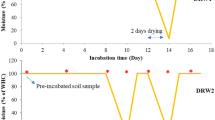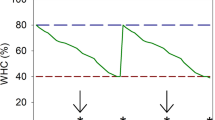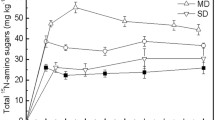Abstract
Purpose
Variation in soil moisture content can change metal availability. However, the effects of soil drying during wetting-drying cycles on metal availability have been little investigated. Metal availability to an imposed sink can be assessed by the diffusive gradients in thin film (DGT) technique. The purpose of this study was therefore to investigate the effects of the soil drying processes and previous soil moisture contents on metal availability using DGT.
Materials and methods
Two metal-polluted agricultural soils with contrasting pH (one acid and one calcareous) were collected from agricultural fields and were repeatedly phytoextracted with a Zn/Cd hyperaccumulator. Both soils, with and without phytoextraction, were subjected to two soil drying processes, i.e. drying from flooded conditions to 50 % maximum water holding capacity (WHC) and drying from 100 to 30 % WHC. Changes in metal availability induced by changing soil water moisture were examined using DGT.
Results and discussion
In acid soils, the availability of cadmium (Cd), zinc (Zn) and nickel (Ni) (but not copper) increased with drying from saturation to 50 % WHC. Drying soil from 100 to 30 % WHC had weak or no significant effects on available metals. Availabilities of Cd, Ni and Zn correlated well with available Al for both drying conditions. In calcareous soil, a decreasing trend of metal availability with soil drying from saturation to 50 % WHC or from 100 to 30 % WHC was found. Soils were also subjected to different wetting-drying cycles prior to drying. In acid soil, available copper (Cu) was correlated with dissolved organic carbon (DOC). Available Cd, Ni and Zn were correlated with available Al and increased with soil wetting-drying cycles in phytoextracted soil, but not in non-remediated soil. In calcareous soil, available Cu and Ni were correlated well with DOC and were higher with long dry periods. However, available Cd and Zn were lower in soils dried from the cycle of saturation to 50 % WHC.
Conclusions
The results indicate that soil water regimes can be manipulated to alleviate soil metal availability, but they must be tailored to individual metals and different soil types, and soil moisture content before drying should be considered when dried soils are used for evaluation of metal availability.



Similar content being viewed by others
References
Amery F, Degryse F, Cheyns K, De Troyer I, Mertens J, Merckx R, Smolders E (2008) The UV-absorbance of dissolved organic matter predicts the fivefold variation in its affinity for mobilizing Cu in an agricultural soil horizon. Eur J Soil Sci 59:1087–1095
Arunakumara KKIU, Walpola BC, Yoon MH (2012) Current status of heavy metal contamination in Asia’s rice lands. Rev Environ Sci Biotechnol 12:355–377
Axe L, Trivedi P (2002) Intraparticle surface diffusion of metal contaminants and their attenuation in microporous amorphous Al, Fe, and Mn oxides. J Colloid Interface Sci 247:259–265
Blaylock MJ, Salt DE, Dushenkov S, Zakharova O, Gussman C, Kapulnik Y, Ensley BD, Raskin I (1997) Enhanced accumulation of Pb in Indian mustard by soil-applied chelating agents. Environ Sci Technol 31:860–865
Borch T, Kretzschmar R, Kappler A, Van Cappellen P, Ginder-Vogel M, Voegelin A, Campbell K (2010) Biogeochemical redox processes and their impact on contaminant dynamics. Environ Sci Technol 44:15–23
Borken W, Matzner E (2009) Reappraisal of drying and wetting effects on C and N mineralization and fluxes in soils. Glob Chang Biol 15:808–824
Cater HT, Tipping E, Koprivnjak JF, Miller MP, Cookson B, Hamilton-Taylor J (2012) Freshwater DOM quantity and quality from a two-component model of UV absorbance. Water Res 46:4532–4542
Chow AT, Tanji KK, Gao SD, Dahlgren RA (2006) Temperature, water content and wet-dry cycle effects on DOC production and carbon mineralization in agricultural peat soils. Soil Biol Biochem 38:477–488
Cornu JY, Denaix L, Schneider A, Pellerin S (2007) Temporal evolution of redox processes and free Cd dynamics in a metal-contaminated soil after rewetting. Chemosphere 70:306–314
Davison W, Zhang H (1994) In situ speciation measurements of trace components in natural waters using thin-film gels. Nature 367:546–548
Davison W, Hooda PS, Zhang H, Edwards AC (2000) DGT measured fluxes as surrogates for uptake of metals by plants. Adv Environ Res 3:550–555
de Vries W, McLaughlin MJ, Groenenberg JE (2011) Transfer functions for solid-solution partitioning of cadmium for Australian soils. Environ Pollut 159:3583–3594
Drenovsky RE, Vo D, Graham KJ, Scow KM (2004) Soil water content and organic carbon availability are major determinants of soil microbial community composition. Microb Ecol 48:424–430
Du Laing G, Meers E, Dewispelaere M, Vandecasteele B, Rinklebe J, Tack FMG, Verloo MG (2009a) Heavy metal mobility in intertidal sediments of the Scheldt estuary: field monitoring. Sci Total Environ 407:2919–2930
Du Laing G, Rinklebe J, Vandecasteele B, Meers E, Tack FM (2009b) Trace metal behaviour in estuarine and riverine floodplain soils and sediments: a review. Sci Total Environ 407:3972–3985
Fageria NK, Carvalho GD, Santos AB, Ferreira EPB, Knupp AM (2011) Chemistry of lowland rice soils and nutrient availability. Commun Soil Sci Plan 42:1913–1933
Fest EPMJ, Temminghoff EJM, Comans RAJ, van Riemsdijk WH (2008) Partitioning of organic matter and heavy metals in a sandy soil: effects of extracting solution, solid to liquid ratio and pH. Geoderma 146:66–74
Frohne T, Rinklebe J, Diaz-Bone RA (2014) Contamination of floodplain soils along the Wupper River, Germany, with As, Co, Cu, Ni, Sb, and Zn and the impact of pre-definite redox variations on the mobility of these elements. Soil Sediment Contam 23:779–799
Groenenberg JE, Römkens PFAM, Comans RNJ, Luster J, Pampura T, Shotbolt L, Tipping E, de Vires W (2010) Transfer functions for solid-solution partitioning of cadmium, copper, nickel, lead and zinc in soils: derivation of relationships for free metal ion activities and validation with independent data. Eur J Soil Sci 61:58–73
Grybos M, Davranche M, Gruau G, Petitjean P (2007) Is trace metal release in wetland soils controlled by organic matter mobility or Fe-oxyhydroxides reduction? J Colloid Interface Sci 314:490–501
Grybos M, Davranche M, Gruau G, Petitjean P, Pedrot M (2009) Increasing pH drives organic matter solubilization from wetland soils under reducing conditions. Geoderma 154:13–19
Guo XB, Drury CF, Yang XM, Reynolds WD, Zhang RD (2012) Impacts of wet-dry cycles and a range of constant water contents on carbon mineralization in soils under three cropping treatments. Soil Sci Soc Am J 76:485–493
Hu PJ, Li Z, Yuan C, Ouyang YN, Zhou LQ, Huang JX, Huang YJ, Luo YM, Christie P, Wu LH (2013) Effect of water management on cadmium and arsenic accumulation by rice (Oryza sativa L.) with different metal accumulation capacities. J Soils Sediments 13:916–924
Huang ZY, Chen T, Yu JA, Zeng XC, Huang YF (2011) Labile Cd and Pb in vegetable-growing soils estimated with isotope dilution and chemical extractants. Geoderma 160:400–407
Jarvis P, Rey A, Petsikos C, Wingate L, Rayment M, Pereira J, Banza J, David J, Miglietta F, Borghetti M (2007) Drying and wetting of Mediterranean soils stimulates decomposition and carbon dioxide emission: the “Birch effect”. Tree Physiol 27:929–940
Jiang JP, Wu LH, Li N, Luo YM, Liu L, Zhao QG, Zhang L, Christie P (2010) Effects of multiple heavy metal contamination and repeated phytoextraction by Sedum plumbizincicola on soil microbial properties. Eur J Soil Biol 46:18–26
Kashem MA, Singh BR (2004) Transformations in solid phase species of metals as affected by flooding and organic matter. Commun Soil Sci Plan 35:1435–1456
Li Z, Wu LH, Hu PJ, Luo YM, Zhang H, Christie P (2014a) Repeated phytoextraction of four metal-contaminated soils using the cadmium/zinc hyperaccumulator Sedum plumbizincicola. Environ Pollut 189:176–183
Li ZY, Ma ZW, van der Kuijp TJ, Yuan ZW, Huang L (2014b) A review of soil heavy metal pollution from mines in China: pollution and health risk assessment. Sci Total Environ 468–469:843–853
Liu JB, Hou HJ, Sheng R, Chen Z, Zhu YJ, Qin HL, Wei WX (2012) Denitrifying communities differentially respond to flooding drying cycles in paddy soils. Appl Soil Ecol 62:155–162
Lundquist EJ, Jackson LE, Scow KM (1999) Wet-dry cycles affect dissolved organic carbon in two California agricultural soils. Soil Biol Biochem 31:1031–1038
Menzies NW, Donn MJ, Kopittke PM (2007) Evaluation of extractants for estimation of the phytoavailable trace metals in soils. Environ Pollut 145:121–130
Naidu R, Kookana RS, Sumner ME, Harter RD, Tiller KG (1997) Cadmium sorption and transport in variable charge soils: a review. J Environ Qual 26:602–617
Rennert T, Meissner S, Rinklebe J, Totsche KU (2010) Dissolved inorganic contaminants in a floodplain soil: comparison of in situ soil solutions and laboratory methods. Water Air Soil Pollut 209:489–500
Rupp H, Rinklebe J, Bolze S, Meissner R (2010) A scale-dependent approach to study pollution control processes in wetland soils using three different techniques. Ecol Eng 36:1439–1447
Shaheen SM (2009) Sorption and lability of cadmium and lead in different soils from Egypt and Greece. Geoderma 153:61–68
Shaheen SM, Rinklebe J, Rupp H, Meissner R (2014a) Temporal dynamics of pore water concentrations of Cd, Co, Cu, Ni, and Zn and their controlling factors in a contaminated floodplain soil assessed by undisturbed groundwater lysimeters. Environ Pollut 191:223–231
Shaheen SM, Rinklebe J, Rupp H, Meissner R (2014b) Lysimeter trials to assess the impact of different flood-dry-cycles on the dynamics of pore water concentrations of As, Cr, Mo and V in a contaminated floodplain soil. Geoderma 228:5–13
Tack FMG, Van Ranst E, Lievens C, Vandenberghe RE (2006) Soil solution Cd, Cu and Zn concentrations as affected by short-time drying or wetting: the role of hydrous oxides of Fe and Mn. Geoderma 137:83–89
Tandy S, Mundus S, Yngvesson J, de Bang TC, Lombi E, Schjoerring JK, Husted S (2011) The use of DGT for prediction of plant available copper, zinc and phosphorus in agricultural soils. Plant Soil 346:167–180
Tang XY, Katou H, Suzuki K, Ohtani T (2011) Air-drying and liming effects on exchangeable cadmium mobilization in contaminated soils: a repeated batch extraction study. Geoderma 161:18–29
Tipping E, Corbishley HT, Koprivnjak JF, Lapworth DJ, Miller MP, Vincent CD, Hamilton-Taylor J (2009) Quantification of natural DOM from UV absorption at two wavelengths. Environ Chem 6:472–476
Wang B, Huang B, Qi YB, Hu WY, Sun WX (2012) Effect of air drying on speciation of heavy metal in flooded rice paddies. Chin Chem Lett 23:1287–1290
Williams PN, Zhang H, Davison W, Zhao SZ, Lu Y, Dong F, Zhang L, Pan Q (2012) Evaluation of in situ DGT measurements for predicting the concentration of Cd in Chinese field-cultivated rice: impact of soil Cd:Zn ratios. Environ Sci Technol 46:8009–8016
Xia JG, Zhong YM, Cao XX (2011) Relation between phosphorous release and soil character with alternative dry-wet conditions. J Soil Water Conserv 25:237–242 (in Chinese)
Xu JZ, Wei Q, Yu YM, Peng SZ, Yang SH (2013) Influence of water management on the mobility and fate of copper in rice field soil. J Soils Sediments 13:1180–1188
Yamaguchi N, Nakamura T, Dong D, Takahashi Y, Amachi S, Makino T (2011) Arsenic release from flooded paddy soils is influenced by speciation, Eh, pH, and iron dissolution. Chemosphere 83:925–932
Yang JC, Huang DF, Duan H, Tan GL, Zhang JH (2009) Alternate wetting and moderate soil drying increases grain yield and reduces cadmium accumulation in rice grains. J Sci Food Agric 89:1728–1736
Yu KW, Bohme F, Rinklebe J, Neue HU, DeLaune RD (2007) Major biogeochemical processes in soils—a microcosm incubation from reducing to oxidizing conditions. Soil Sci Soc Am J 71:1406–1417
Zhang H, Zhang SF, Yang JC, Zhang JH, Wang ZQ (2008) Postanthesis moderate wetting drying improves both quality and quantity of rice yield. Agron J 100:726–734
Zhu QH, Huang DY, Liu SL, Zhou B, Luo ZC, Zhu HH (2012) Flooding-enhanced immobilization effect of sepiolite on cadmium in paddy soil. J Soils Sediments 12:169–177
Acknowledgments
This research was supported by the National Natural Science Foundation of China (41325003, 41271326) and the National High Technology Research and Development Program (‘863’ Program) of China (2012AA06A204).
Author information
Authors and Affiliations
Corresponding authors
Additional information
Responsible editor: Yong Sik Ok
Electronic supplementary material
Below is the link to the electronic supplementary material.
ESM 1
(DOCX 20 kb)
Rights and permissions
About this article
Cite this article
Li, Z., Wu, L., Zhang, H. et al. Effects of soil drying and wetting-drying cycles on the availability of heavy metals and their relationship to dissolved organic matter. J Soils Sediments 15, 1510–1519 (2015). https://doi.org/10.1007/s11368-015-1090-x
Received:
Accepted:
Published:
Issue Date:
DOI: https://doi.org/10.1007/s11368-015-1090-x




